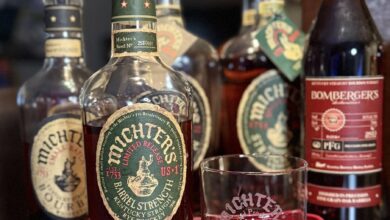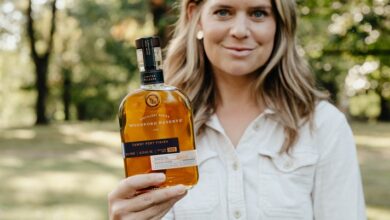The Pennsylvania Rye Revival
By Richard Thomas

(Credit: Richard Thomas)
The meteoric rise of craft whiskey distilling in America has yielded many fruits, and among the most talked about have been the spirit of innovation and (recently) the emergence of American single malts. While the novelty of experimental techniques or unexplored styles have their attractions, I think most drinks writers are missing something important by focusing on the new and sparkly, and I say that because whiskey enthusiasts are fundamentally traditionalists by nature. One needs only look across the Atlantic and see how some modest, suggested revisions to Scotch Whisky rules were met late last year to see that.
Keeping that in mind, I think the most overlooked, and arguably the most important, outcome of the craft whiskey movement is taking place not in the Pacific Northwest, Texas or Colorado, but in a place where whiskey was truly historic, but became extinct: Pennsylvania. If whiskey fans love old ways and old drinks, then they’ll come to adore the revival of the Monongahela style by Keystone State craft distillers.
Monongahela Whiskey
After decades of post-Prohibition decline, the endgame of Pennsylvania whiskey-making began with the 1987 purchase of the holding company that owned Old Overholt by Jim Beam, who moved the brand to their Clermont, Kentucky distillery. From that point forward, Old Overholt ceased to be a Pennsylvania-style Rye and became a Kentucky-style Rye (i.e. made with a mash bill with using a proportion of rye just slightly higher than the minimum 51% required by law and plenty of corn). This was the death knell of Pennsylvania Rye, because for two decades Old Overholt had been the only brand of that style in national distribution. Two years later, the last operating distillery in the state, Bomberger’s, closed its doors forever.

(Credit: Richard Thomas)
What Pennsylvania Whiskey specifically means is a matter for debate, however, because the style had and has no formal definition beyond the requirement that it be made in Pennsylvania (similarly, Tennessee Whiskey was ill-defined until the passage of a state whiskey law in 2013). In its broad strokes, Pennsylvania Whiskey is big, bold, chewy Rye Whiskey, and it’s that way because it’s made using a high rye, no corn mash bill and the sweet mash technique. The latter differs from the sour mash method so often seen in Kentucky in that no backset is kept from the previous round of fermentation to kickstart the chemistry in the next one, so each batch starts anew.
Several years ago, a sudden craze for Rye Whiskey, driven in large part by mixologists working with pre-Prohibition cocktail recipes, caught the big distillers off-guard. The craze caused a crunch, rye whiskey was in short supply, and craft distillers moved into that vacuum with a gusto. In Pennsylvania, this led straight to the traditions of what had, once upon a time, been one of America’s great whiskey states.
Then and now, the traditions of Pennsylvania Whiskey were more ethos and guideline than hard and fast rules. The revival has come hand in hand with research and debate over what those traditions actually were, and no one should expect a single distillery to apply them all. In particular, I don’t see anyone rebuilding Old Overholt’s famous, pre-Prohibiton era climate-controlled warehouses anytime soon, although the state’s idiosyncratic three-chamber pot still just might catch on again.
Bluebird Distilling
This small outfit in little Phoenixville, not even 30 miles from downtown Philadelphia, is a newcomer to Keystone craft distilling. Even so, they’ve staked a spot in the state’s whiskey comeback with a 100% rye grain whiskey.

(Credit: Richard Thomas)
Dad’s Hat
This craft distillery on the outskirts of Philadelphia was built around founder Herman Mihalich’s and John Cooper’s memories of the trappings of their fathers: hats and Pennyslvania Rye. Their rye whiskey is made using that big rye, no corn mash bill: 80% rye, 5% malted rye, 15% malted barley.
Moreover, Dad’s Hat shares something in common with what Garrison Brothers brought to Texas Bourbon and Westland has done for American Malt: singular focus. Whereas most craft distilleries make a handful of spirits, Dad’s Hat focuses on Rye and Rye alone. This is probably why they were the first of the Pennsylvania Rye Revival distilleries to release a bottled in bond version of their whiskey.
Liberty Pole Spirits
The no-corn style of this Western Pennsylvania craft distillery expresses itself in a mash bill of 61$ rye, 13% malted rye, 13% wheat and 13% malted barley. The twist in their production method is they triple distill their whiskey out of a pot still, giving Monongahela Whiskey something of an Irish twist.
Wigle Whiskey
Located in the heart of Monongahela Country in Pittsburgh, founders Meredith and Alex Grelli have a passion for rye whiskey, displayed in their extensive and complicated list of releases. Wigle uses a variety of mashbills, and many of their rye whiskeys rely on a recipe that is 2/3s rye and the rest is wheat and malted barley. Either way, what they are doing is definitely part of revival in Western Pennsylvania. Like Dad’s Hat, Wigle has contributed maturity to both craft whiskey and the Pennsylvania Revival by releasing a bottled in bond version of their Rye.




Missing on your list, the Willett 4 year, is 95% Rye 5% Barley. Not sure it’s Bonded at least by age. The 3 years is also a high rye (blend of two mashbill ryes, of some 51% and a majority 74% rye) but it does have a touch of corn. The 4 year is only recently available. I poured the willett 4 and Dad’s Hat tonight, side by side. Willett as robust in rye and more balanced with age than the dad’s hat. The dad’s hat I like the malting of the rye and barley for a cereal note. FWIW, to my tastes, the Willett 4 year is twice the price, but the better flavor all rye no corn bottle. http://thewhiskeyjug.com/rye-whiskey/willett-single-barrel-rye-4-yrs-old/
It’s not missing. It’s not made in Pennsylvania. See the title.
It’s too bad that all we can get is craft rye. The whole idea of Pennsylvania rye is that it was made in in industrial quantity in big beautiful factories. No batch numbers and 100 dollar bottles, every bottle the same.
Unfortunately, those days are gone. The best we might see in our lifetimes is if a big liquor company buys one of the leaders of the Pennsylvania revival and develops it into a medium-sized distillery and brand, akin to (ironically) the new version of Michter’s.